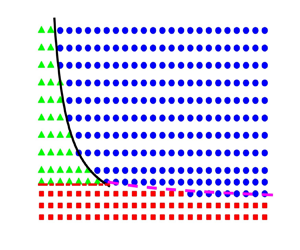Published online by Cambridge University Press: 07 February 2022

The instability characteristic of a viscoelastic jet in a co-flowing gas stream is studied comprehensively. The important role of the non-uniform basic velocity in the instability analysis of viscoelastic jets is clarified, which first induces an unrelaxed elastic tension, and then produces a coupling term between the elastic tension and perturbation velocity. The elastic tension promotes the instability of the jet, while the coupling term exhibits a stabilizing effect, which is essentially related to the nonlinear constitutive relation of viscoelastic fluids and the non-uniform basic velocity. The competition between these two factors leads to the non-monotonic effect of fluid elasticity on the disturbance growth rate, which can be divided into two different regimes characterized by the Weissenberg number with values smaller or larger than unity. In different regimes, the structure of the eigenspectrum is also significantly different. Furthermore, three instability mechanisms are identified using the energy budget analysis, corresponding to the predominance of the surface tension, elastic tension and shear and pressure of the external gas, respectively. By analysing the variations of the growth rate and phase speed of the disturbances, the general features of viscoelastic jet instability are obtained. Finally, the transitions of instability modes in parameter spaces are investigated theoretically and the transition boundaries among them are provided. This study provides guidance for understanding the underlying mechanism of instability of a viscoelastic jet surrounded by a co-flowing gas stream and the transition criterion of different instability modes.